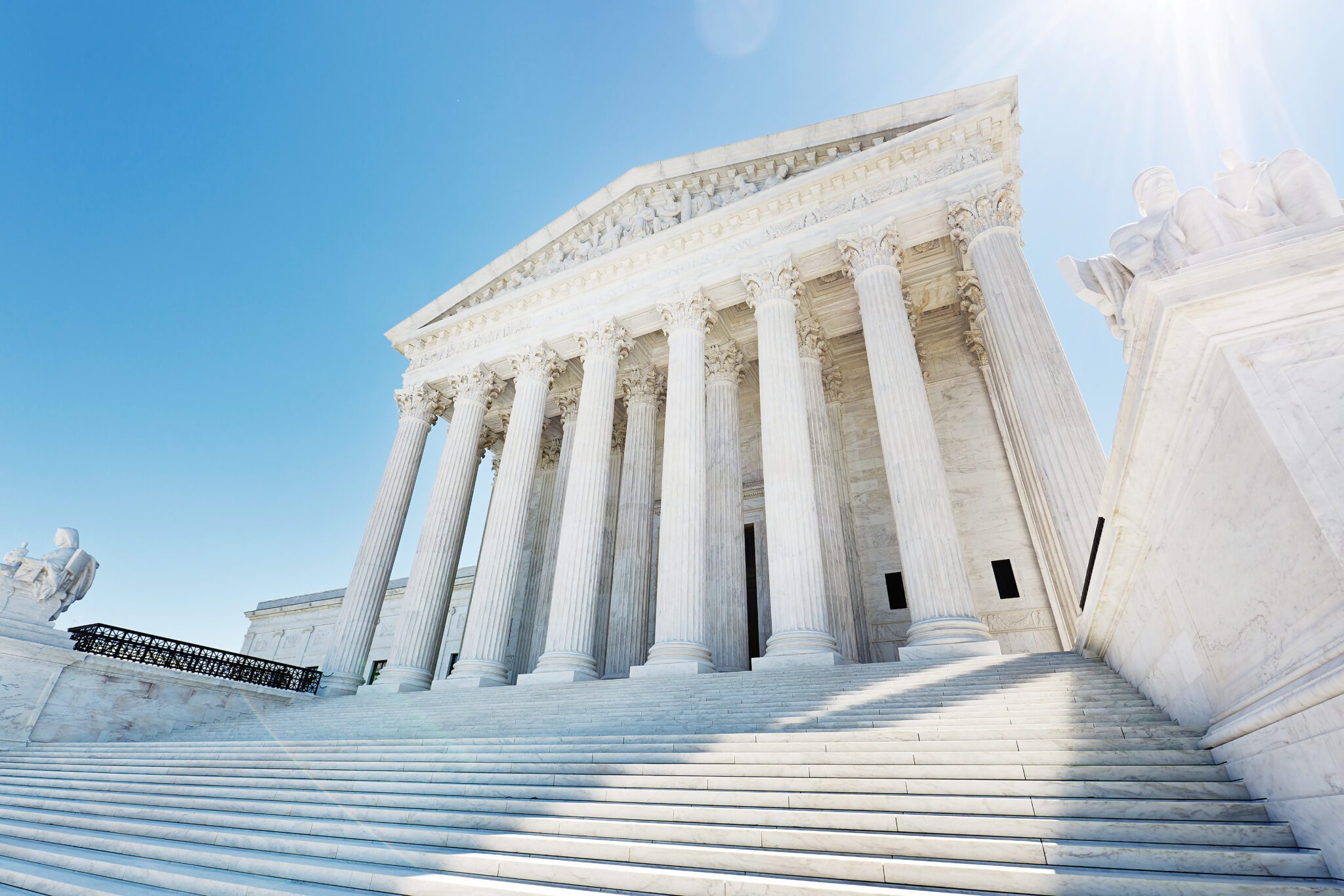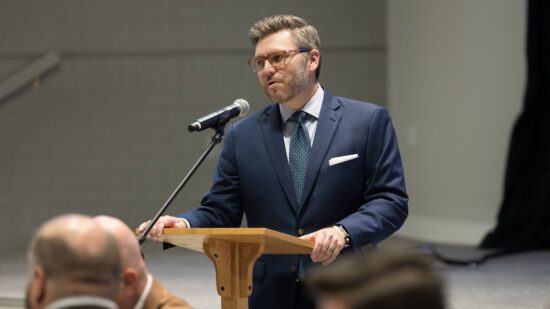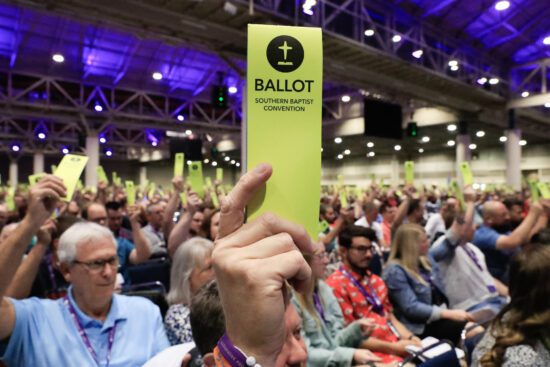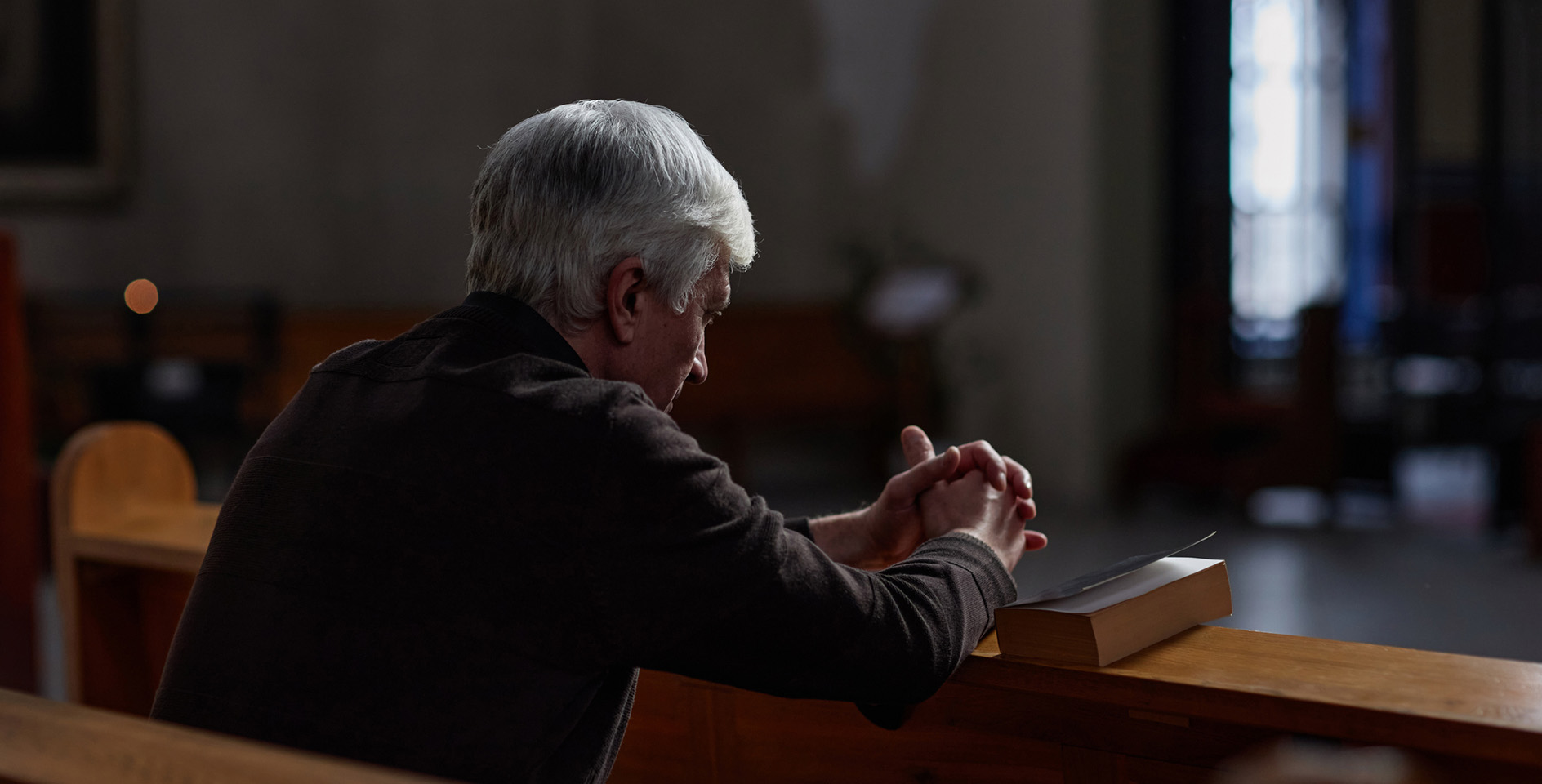Awhile back, the Evangelical Theological Society devoted an annual meeting to “defining evangelicalism’s boundaries,” whether doctrinally, ecclesiologically, or historically. And I got to thinking whether there were aesthetic markers as well.
At the time, I was a Chicago-area pastor, and I thought I’d visit some local churches to see what I might find. I started with First Baptist in Hammond, Indiana, where a big mural of Jack Hyles and his wife graced the side of one of their buildings, he in a royal blue suit. The young security man who showed me around the facilities wore a suit. The auditorium was decked with bunting, stars, and flags for a patriotic program in the wake of 9/11, and the church bulletin spoke of “soul winning.”
The next week, I ran by College Church, out west in Wheaton, Illinois. On this weekday, the staff wore sweaters and other casual clothing. There were no murals of former pastors. A sailing-ship weather vane sat atop the steeple. A promotional note spoke of Christmas Coffees as “a chance to share with your neighbors.”
I imagine you can find fundamentalist churches with “Christmas coffees,” where the staff wear sweaters, and I know some evangelical churches that speak of “soul winning,” but the aesthetic centers of mass are different. This became clearer to me as I tracked the phenomena, from Willow Creek to Moody Memorial to St. Joseph Catholic in Wilmette to Averyville Baptist in East Peoria, as well as to a range of bookstores and websites.
Here are some observations about the various aesthetic centers of mass to be found within American Christendom.
Dress and Grooming
Fundamentalists favored short hair and a clean-shaven look. Turning through Hammond’s photo booklet, I saw 33 men in various leadership positions, without so much as a mustache. In the Willow Creek welcome booklet, I found a mustache, a beard, and a nascent beard.
The Hammond bulletin announced guided tours of Hyles-Anderson College and invited you to meet up with one of the hosts, pictured in a white sport coat. When you visited their website, you read that women must not wear shorts, slacks, or skirts which ended above the knees. Men had to wear ties to class. (The Wheaton College website gave a different picture.)
Evangelicals seemed to dress according to their particular “tribe.” The Promise Keepers and Willow Creek contingent were given to polo shirts, khaki pants, fleece, and golf wear. The Mars Hill/Books and Culture group was keener toward Clark shoes, facial hair, and corduroy. The Grunge evangelicals favored a Kurt Cobain look, with body piercing, grays and browns, flannel, and frayed edges. Generally speaking, they tended toward natural fibers, though some of the older Billy Graham Evangelistic Association group turned to the comfort that came with synthetic fibers.
Graphics
The pastor of Averyville Baptist Church in East Peoria, Illinois, had a treasure trove of fundamentalist publications, to which he graciously gave me access. Turning through Sword of the Lord, Revival Fires, The Baptist Contender, Regions Beyond, The Temple Trumpet, Valiant for Truth, The Baptist Pillar, Baptist Bible Tribune, The Baptist Evangel, and The Flaming Torch, I noticed certain patterns: 1) Pages devoid of illustration, sidebars, and white space held as many as 2,500 words each; 2) The colors of choice were black and red; white lettering was often nested in side-to-side bands in these colors; 3) The American flag was common, even on issues published before 9/11; 4) They favored literal, simple line drawings with text and citation, e.g. a shield with superimposed sword, “John 17:17,” and “…thy word is truth”; the front of a columned Greek building with “KJV 1611” writ large; a collage of Bibles over crosses, two flaming torches, and a rippling American flag.
Evangelical graphics were more understated—fewer swords and more wind and grain; abstract or stylized rather than literal illustration; two-color rather than black-and-white or four-color, the look of choice in church bulletins. (Burgundy and slate blue were popular; in fact, they preferred colors requiring a qualifying adjective—not just orange, but burnt orange) Christianity Today’s Books and Culture was a paradigm; caricature was popular (perhaps with a debt to David Levine’s work in The New York Review of Books), as was the venerable woodcut look.
The cover of Willow Creek’s welcome booklet was over 70% white space, with Land’s End-clothed, inch-tall figures floating in this medium. Inside the back cover, a wide shot of their campus, taken in the golden hour before sundown, rested on blueberry matte, which accounted for 80% of the space. On the facing page, you saw a laid back family, a father with a mustache and “coat-of-many-colors,” a multi-textured, asymmetrical-patterned sweater. His son, with floppy sweater, cargo pants, and an insouciant shoelace lying on the ground to his left, stood with arms crossed. The mother and two daughters assumed cross-legged poses on the floor, elbows on knees, chins on fists. These people were pretty cool, pretty evangelical.
An Anglican feel was also gaining currency. British crests were popular, as was Latin. (The logo of the Alliance of Confessing Evangelicals featured Post Tenebras Lux.) Fundamentalists employed shields in their logos, but these were more typically filled with line drawings of a variety of objects, one for each quadrant. (See, for example, the Hyles-Anderson College version, with its Bible, harp, balance, and lamp.) The Southern Baptist Theological Seminary produced two logos at different points on the spectrum, with the main one having a more evangelically graceful and abstract dove, Word, and cross, integrated in a fashion reminiscent of a British coat of arms.
Fundamentalist publications and advertisements showed a heart for hovering, shadowed letters with sunbursts and highlights. Evangelical print was more reserved.
Jack Chick’s work was prototypically fundamentalist. His virtually wordless tract, “One Way,” was obviously designed for children. Along the way, we saw a skull and crossbones, boils, squiggly stench lines arising from dead bodies, circling insects, the fires and smoke of hell, and blood dripping from a crucified Jesus on bowing children, with hearts of love drifting upward from them.
As for framed prints, fundamentalists were more inclined to go with Salman’s Head of Christ, while Ron DiGiani’s The Servant better served the evangelicals. (In the latter painting, Jesus washes the feet of a businessman slumped in high-backed, red leather chair beside his elegant desk. He wears braces and a rep tie.)
Along the way, I was reminded of the newer sports franchises, whose color choices favored a more evangelical look, leaving the older teams to go with fundamentalist colors. Before the 1980s, teams favored red, white, and/or blue (Cubs; Cardinals; Red Sox; Giants; Cowboys; Lions; Canadians; Redwings; Flyers; Bulls; Pistons; Sixers); or black, navy, white, and/or gray (Sox; Yankees; Raiders). But then came an explosion of teal and/or purple (Diamondbacks; Hornets; Rockies; Marlins; Devil Rays; Mighty Ducks; Ravens). These were the colors you found at the Promise Keepers store as well.
Language
Fundamentalist expression came in a hotter style. For instance, a front page of Sword of the Lord ran an article by John R. Rice, with the terms “wickedness” and “apostasy.” There were six exclamation marks in the first eight paragraphs. And the paper’s credo was edgy – “Opposing Modernism, Worldliness and Formalism.” The same was true for the other lead slogans I found in the Avery Baptist collection —“Earnestly Contending for the Defense and Proclamation of Baptist Distinctives and Old-Time Religion”; “Canada’s Only True Baptist Paper”; “A Bible Believing Independent Baptist Publication.” And I saw no evidence that they’d spent time worrying whether ‘Community’ would attract anyone other than ‘Baptists.’
The view book at Hammond showed the leaders for the “Deaf Department,” the “Blind Department,” and the “Oriental Ministry.” An evangelical church is more inclined to speak of the hearing impaired, visually impaired, and Asians. Political correctness or sensitivity is not the Fundamentalist strong suit.
Evangelical expression was typically more neighborly and rounded off. The College Church newsletter announced the availability of “assistive listening devices” in the “narthex,” and not “hearing aids in the lobby.”
Catholics and Evangelicals
Though some Catholic images reflected the investment of great wealth, e.g. St. Peters in Rome, Catholic publications were, for the most part, quite modest in appearance, perhaps because of their identification with the poor. (See Dorothy Day’s The Catholic Worker as a model.) Instead of the sharp graphics of a Christianity Today, they were more given to folkish drawings, such as those Annie Vallotton did for the Good News Bible. Furthermore, they were not averse to the dense print/mimeograph look of fundamentalist newsletters. And such icons as the Mother Angelica on EWTN were not particularly cool. With her fleshy face, eye patch, and dated glasses, she exhibited little of the smoothness of Willow Creek.
When I visited a traditional Roman Catholic bookstore, I saw a lot of devotional literature marked by images of 1950s families, halos, sunbursts, thorn-circled and immaculate hearts on Jesus’ and Mary’s chests, and hovering flames and doves. And, to continue the sports-team-color analogy, I think the Catholic palette more nearly featured the old-school orange, yellow, green, and brown, chosen by the A’s, Packers, Browns, Jets, Celtics, and Astros.
Evangelicals and Pentecostals
When I lived in Indianapolis in the late 1980s, a procession of national denominational meetings came through the Hoosier Dome. Each had pressing issues: for the UCC, it was whether to seat gay members; for the Nazarenes, it was whether or not to allow attendance at movies. When the Pentecostals came to town, the local religion writer had to explain that there were two camps—the big hair, heavy makeup group, exemplified by Tammi Bakker, and the no-makeup, hair-in-a-bun group, given to high-collared, long, print dresses. Both fundamentalism and Pentecostalism had a basic blue collar feel, but the differences were striking. Pentecostals were more likely to be flamboyant; you’d rarely find Paul Crouch’s furniture or a Benny Hinn comb-over-and-Nehru-jacket combination on a fundamentalist platform—or on an evangelical platform, for that matter. Furthermore, Anne Graham Lotz and Kay Arthur wouldn’t think of attempting the Tammi Faye Bakker or Jan Crouch look.
(Now and then, Pentecostals adopt something of an evangelical look; Kenneth Copeland puts on the crew neck sweater and sits down at the kitchen table for coffee, but the voice and eyes are fundamentalist hot, not Bill Hybels or Leighton Ford cool.)
Fluidity
Of course, none of this is static. Styles change in churches as well as on the runways of Dior and Armani. But distinctions will be evident. “Millennial” evangelicals often preach in jeans (sometimes “pre-stressed” or torn) and untucked shirts. They sport the haven’t-shaved-in-two-days look. Some seem to pay homage to a “product”-enhanced version of Martin Short’s Ed Grimley peak on SNL. Who knew this would catch on?
In contrast, middle-aged evangelicals are becoming more adept at arranging pocket handkerchiefs, sporting French cuffs, tying bow ties, and such.
In graphics, evangelical designers are monkeying around with all sorts of styles, borrowing from bombastic detergent boxes, claymation, Orthodox iconography, or whatever they please.
So what?
Let’s close with some words of context:
1. Aesthetic concerns do matter. Do you ever see overweight men in malls wearing tank top, Crocks, black knee-length nylon socks, and tight purple coaching shorts? Not so easy on the eyes. Or does anyone think that a mangy dog crossing a crumbling asphalt expanse in front of a boarded up building is as pleasant or engaging as sunset at Big Sur? Some things really do reward the senses; some things punish them – whether we’re talking storefront, tabloid, sidewalk traffic, or church.
2. God’s creation features a lot of winsome aesthetic diversity. His garden includes begonias, orchids, roses, sunflowers, daisies, etc., and not just a sea of tulips (no pun intended).
3. Truth is more important than aesthetics. Christianity is a propositional faith at base, not a graphics faith. Let’s not establish Aesthetes for Christ. We die for creeds, not pleats.
4. Aesthetic pride is deadly. The Hindus have their untouchables to patronize or shun; some Evangelicals treat the Duck Dynasty gang as their Dalits. Not only is this spiritually dangerous; it’s socially risky, in that snootiness can come back to bite you.
5. Aesthetic pragmatism insults the Holy Spirit and the Word. Those who think they can build a church by cultivating a look and feel, and that they can’t build it without such ambiance, simply don’t understand the power of gospel.










